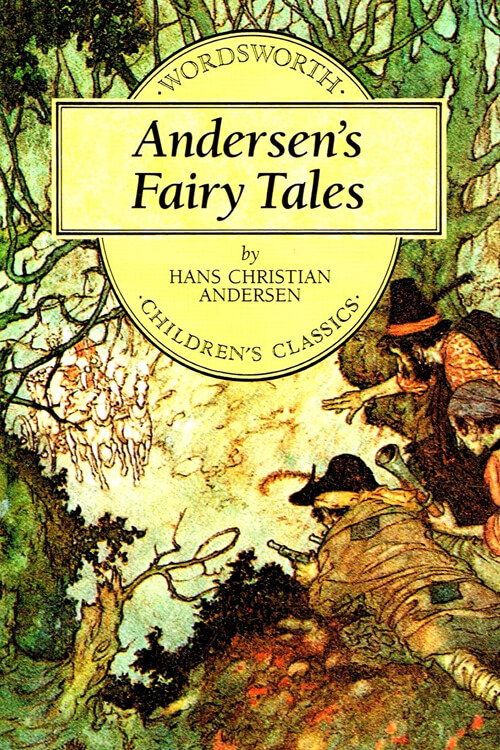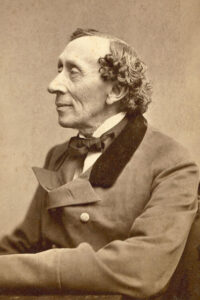
Fairy Tales of Hans Christian Andersen
In the garden, all the apple trees were in blossom. They had hastened to bring forth flowers before they got green leaves, and in the yard, all the ducklings walked up and down, and the cat too: it basked in the sun and licked the sunshine from its paws. And when one looked at the fields, how beautifully the corn stood and how green it shone, without comparison! and there was a twittering and a fluttering of all the little birds as if the day were a great festival; and so it was, for it was Sunday. All the bells were ringing, and all the people went to church, looking cheerful, and dressed in their best clothes. There was a look of cheerfulness in everything. The day was so warm and beautiful that one might well have said: “God’s kindness to us men is beyond all limits.” But inside the church, the pastor stood in the pulpit and spoke very loudly and angrily. He said that all men were wicked, and God would punish them for their sins and that the wicked, when they died, would be cast into hell, to burn forever and ever. He spoke very excitedly, saying that their evil propensities would not be destroyed, nor would the fire be extinguished, and they should never find rest. That was terrible to hear, and he said it in such a tone of conviction; he described hell to them as a miserable hole where all the refuse of the world gathers. There was no air beside the hot burning sulfur flame, and there was no ground under their feet; they, the wicked ones, sank deeper and deeper, while eternal silence surrounded them! It was dreadful to hear all that, for the preacher spoke from his heart, and all the people in the church were terrified. Meanwhile, the birds sang merrily outside, and the sun was shining so beautifully warm, it seemed as though every little flower said: “God, Thy kindness towards us all is without limits.” Indeed, outside it was not at all like the pastor’s sermon.
The same evening, upon going to bed, the pastor noticed his wife sitting there quiet and pensive.
“What is the matter with you?” he asked her.
“Well, the matter with me is,” she said, “that I cannot collect my thoughts, and am unable to grasp the meaning of what you said today in church—that there are so many wicked people, and that they should burn eternally. Alas! eternally—how long! I am only a woman and a sinner before God, but I should not have the heart to let even the worst sinner burn forever, and how could our Lord do so, who is so infinitely good, and who knows how the wickedness comes from without and within? No, I am unable to imagine that, although you say so.”
Read or download Book
Hans Christian Andersen
Hans Christian Andersen (2 April 1805 – 4 August 1875) was a Danish author. Although a prolific writer of plays, travelogues, novels, and poems, he is best remembered for his literary fairy tales.
Andersen’s fairy tales, consisting of 156 stories across nine volumes, have been translated into more than 125 languages. They have become embedded in Western collective consciousness, accessible to children as well as presenting lessons of virtue and resilience in the face of adversity for mature readers. His most famous fairy tales include “The Emperor’s New Clothes”, “The Little Mermaid”, “The Nightingale”, “The Steadfast Tin Soldier”, “The Red Shoes”, “The Princess and the Pea”, “The Snow Queen”, “The Ugly Duckling”, “The Little Match Girl”, and “Thumbelina”. His stories have inspired ballets, plays, and animated and live-action films.
Early life
Andersen was born in Odense, Denmark, on 2 April 1805. He had a stepsister named Karen. His father, also named Hans, considered himself related to nobility (his paternal grandmother had told his father that their family had belonged to a higher social class, but investigations have disproved these stories). Although it has been challenged, speculation suggests that Andersen was an illegitimate son of King Christian VIII. Danish historian Jens Jørgensen supported this idea in his book H.C. Andersen, en sand myth [a true myth].
Andersen was baptized on 15 April 1805 in Saint Hans Church in Odense. According to his birth certificate, which was not drafted until November 1823, six godparents were present at the baptism ceremony: Madam Sille Marie Breineberg, Maiden Friederiche Pommer, shoemaker Peder Waltersdorff, journeyman carpenter Anders Jørgensen, hospital porter Nicolas Gomard, and royal hatter Jens Henrichsen Dorch.
Andersen’s father, who had received an elementary school education, introduced his son to literature, reading him Arabian Nights. Andersen’s mother, Anne Marie Andersdatter, was an illiterate washerwoman. Following her husband’s death in 1816, she remarried in 1818. Andersen was sent to a local school for poor children where he received a basic education and had to support himself, working as an apprentice to a weaver and, later, to a tailor. At fourteen, he moved to Copenhagen to seek employment as an actor. Having a good soprano voice, he was accepted into the Royal Danish Theatre, but his voice soon changed. A colleague at the theatre told him that he considered Andersen a poet, and taking the suggestion seriously, Andersen began to focus on writing.
Jonas Collin, director of the Royal Danish Theatre, held great affection for Andersen and sent him to a grammar school in Slagelse, persuading King Frederick VI to pay part of his education. Andersen had by then published his first story, “The Ghost at Palnatoke’s Grave” (1822). Though not a stellar pupil, he also attended school at Elsinore until 1827.
He later said that his years at this school were the darkest and most bitter years of his life. At one school, he lived at his schoolmaster’s home. There he was abused and was told that it was done in order “to improve his character.” He later said that the faculty had discouraged him from writing, which resulted in a depression.






